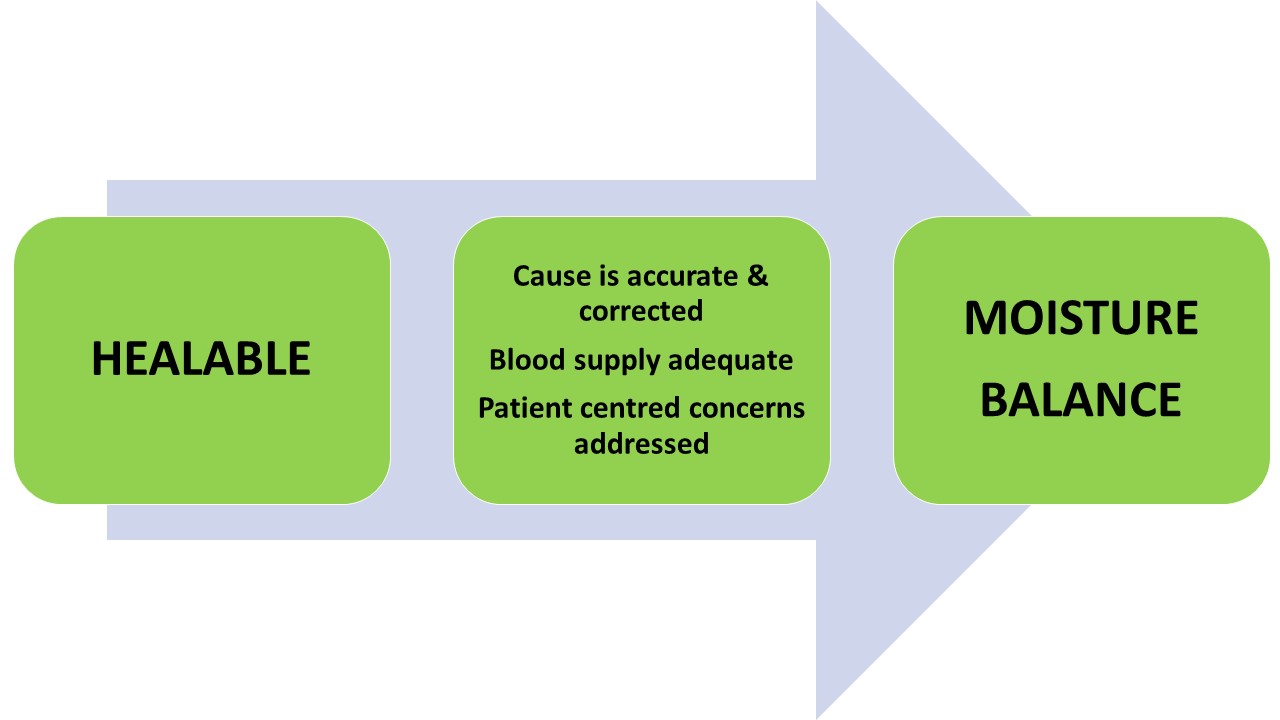Moisture Balance for Healable Wounds
Figure 1. Moisture Balance for Healable Wounds (Goodman, 2021)

George D. Winter’s research (1962) demonstrated that when wounds were maintained in a moist environment with a film covering, this resulted in: faster epithelization, decreased eschar formation, warmer wound surface temperature and double the healing rates. He demonstrated that for healable wounds, a moist environment optimized wound healing.
When the wound bed is kept moist, numerous other events occur that facilitate wound healing. These include:
- Growth factors and proteins are preserved on the wound surface (Tan and Dosan, 2019)
- Matrix destroying enzymes (proinflammatory cytokines and matrix metalloproteinases) are sequestered and decreased (Tan and Dosan, 2019)
- Facilitating movement across the wound surface for keratinocytes, fibroblasts, growth factors and cytokines (Tan and Dosan, 2019)
- Fibroblasts are readily available to stimulate collagen synthesis (Tan and Dosan, 2019)
- Promotion of new tissue growth, to increase re-epithelization rate and overall faster wound healing (Dyson et al, 1998) (Beam, 2008)
- Reduced scarring (Hackl, 2014) (Powers, Morton, Phillips, 2013) (Attinger, et al, 2006)
- Reduced pain perception (Ousey, et al, 2016) (Coutts, Woo, Bourque, 2008)
- Facilitation of autolytic debridement (King, et al, 2014) (Gray, et al, 2010)
Allowing a healable wound to dry out will hamper wound healing. This leads to formation of slough, eschar and tissue necrosis, thereby reducing wound re-epithelization and closure. Preventing a healable wound (or portions of it) from drying out should be in the forefront of provider’s goals. Unfortunately, once necrotic tissue forms, some form of debridement is then needed to regain to the eschar-free pink wound base. This is how many healable wounds exhibit delayed healing and may become chronic. These undesirable tissue changes increase the risk of bacterial damage from superficial critical colonization (local infection) and deep/surrounding wound infection. (Sibbald, Woo, Ayello, 2006) The presence of necrotic tissue increases the bacteria load and becomes an infection risk for the individual. By keeping the healable wound moist, delayed healing cascade and resultant chronic wound status may be prevented.
Every effort should be taken to keep healable wounds moist and in their expected healing trajectory. The quicker an individual’s wound can heal, the less resources are required and outcomes are improved.
For the healable wound, potentially cytotoxic antiseptics are not indicated and should only be introduced for unique situations (e.g., local infection). If a healable wound is observed to suddenly produce some mild odour, green exudate and periwound erythema, this warrants a prompt intervention. One unique example would be if the wound base is observed to have any 3 of the 5 NERDS signs (Nonhealing, Exudate, Red friable granulation, Debris, Smell), this is indicative of local infection and would require use of antibacterial dressing (Sibbald, Woo, Ayello, 2006). Three to five-days of a short-term use of an antiseptic solution during wound cleansing would be a prudent treatment, then return to normal saline cleansing. This is an example where close assessment of a healable wound results in appropriate, timely treatment changes, and can keep the wound in a healing trajectory.
Foams and super absorbents are two different products that manage exudate differently. Reviewing the manufacturer’s information on any wound product is recommended to facilitate appropriate use of resources. See Table 1 for a comparison of foams and super absorbents and their features.
Table 1. Comparison Between Foams and Super Absorbents
| Dressing Category | Features | Average Wear time |
|---|---|---|
Foams Moisture Balance (Moisture Exchange/ Moisture Balance) |
Absorbs low to moderate amount of exudate Fluid exchange (dressing gives back some exudate to prevent wound surface from drying), observe for periwound maceration May be a method of delivery for antibacterial agent (silver) or containing a non-release antibacterial agent for antibacterial action above the wound surface (PHMB, Methylene blue/gentian violet) Optimal when infection is not an immediate concern and exudative levels are under control More expensive ($$$$ per dressing) – requires longer wear time for cost-effective use |
2-7 days |
| Super absorbents Moisture Management (Fluid lock/diaper technology) |
Absorbs a large to excessive amount of exudate Fluid lock technology within the product to keep wound surface at a lower moisture level (diaper technology) Do not cut (absorptive polymers will leak out on the wound surface) Antimicrobials may be used as contact layer under the superabsorbent Optimal when frequent dressing changes are needed or uncontrolled exudative situations E.g., superficial or deep and surrounding tissue infection Less expensive ($ per dressing) |
1-3 days |

